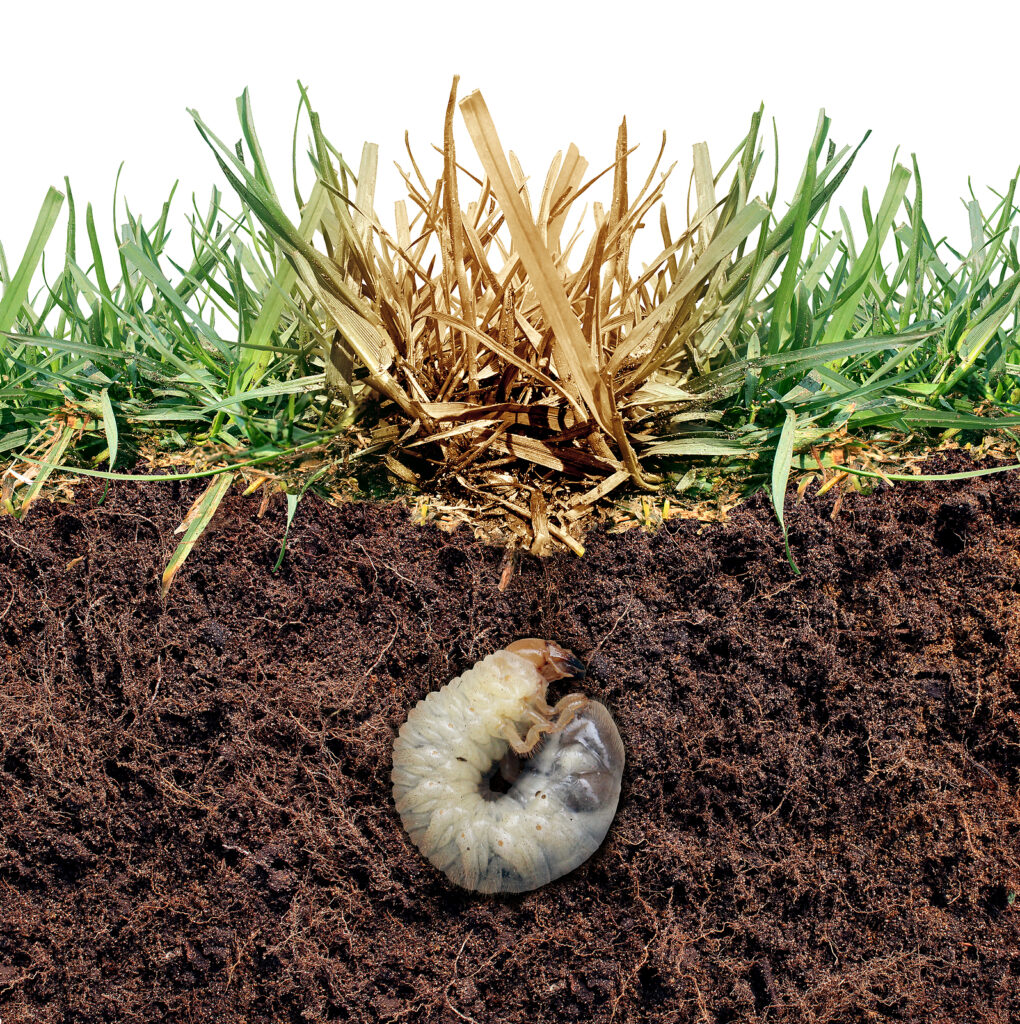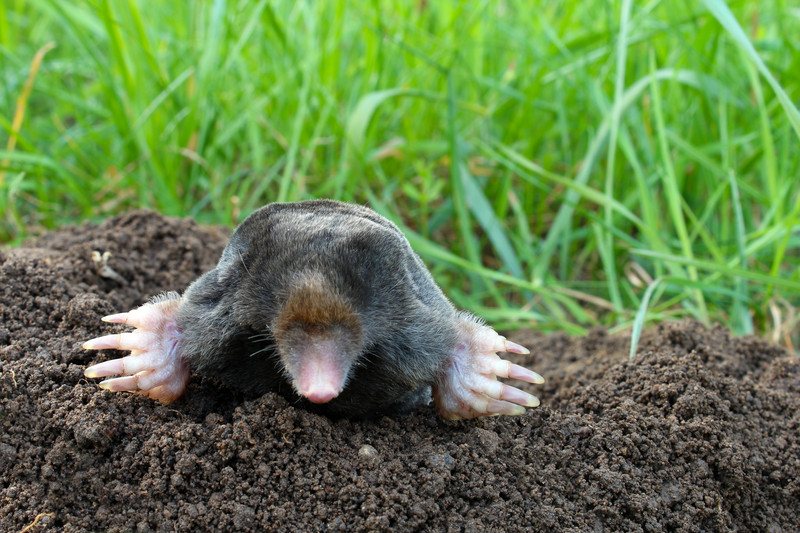Lawn pests most often attack stressed areas of a lawn, not the whole lawn. Areas of lawn that are wet, dry, or shady or the edges of lawns are areas that pests will attack.
When you see an area of lawn has brown patches or yellowing dead spots, get down on your hands and knees and look carefully. From the center of a stressed spot of lawn look to the edges, this is where pests are likely lurking.
Lawn pest damage
Here are common lawn pests and where they attack and feed
- Grass blades: adult billbugs, chinch bugs, clover mites, greenbugs, and leafhoppers.
- Crowns of grass plants: cutworms, fiery skippers, sod webworms, armyworms, and bill bug larvae.
- Grass roots: ground pearls, white grubs, mole crickets, and wireworms.

Common lawn insect pests
Here are common pests that attack lawn grasses. Before the pest is described and control is suggested, the damage will be described.
- Armyworms: leaves small patches of brown turn with grass blades eaten in circular patches. Light tan to dark brown caterpillars with yellow, orange, or dark brown stripes, ¾ to 2 inches long; adult is a tan or mottled gray moth with a 1-inch (2.5cm) wingspan. Spray with Bacillius thuringiensis, carbaryl, diazinon, neem or pyrethrum or use diazinon lawn granules.
- Billbugs: feed on the lawn in a distinct circular pattern; lawn becomes yellowish or brown; larvae feed on roots. Billbug larvae are white legless grubs to ½ inch long; adults are brownish-gray with long snouts use for burrowing and chewing; grubs emerge in late spring. Spray grass and thatch with carbaryl, chlorpyrifos, diazinon, or neem.
- Chinch bugs: create large, circular yellowing patches with brown centers in sunny areas of lawn. Adults are ¼ inch or smaller; most are black with white wings with a distinctive triangular black mark; chinch bugs emerge in spring and feed by sucking juices from grass blades. Push a bottomless coffee can into the soil and fill with water; chinch bugs will float to the surface. Treat with sabadilla, chlorpyrifos, diazinon; reduce nitrogen fertilizer.
- Cutworms: create 1- to 2-inch (2.5-5cm)patches of brown grass in newly seeded and established lawn; they eat plants at the soil level. Larvae of cutworms are gray, brown, or black plump and smooth growing to 2-inches long; they curl tight when disturbed; adults are dark moths that fly at night. More than 10 larvae per square foot is a serious infestation. Control with Bacillus thuringiensis, carbaryl, chlorpyrifos, diazinon, neem, or pyrethrum.
- Fiery skipper: larvae chew grass blades leave 1 to 2-inch dead spots; feed on Bermuda grass, St. Augustine grass, and creeping bentgrass; usually near flowerbeds where adults feed. Adults are dark brown moths with orange spots. Larvae are up to 1 inch (2.5 cm) long and have distinctive reddish markings on the front of what appears to be an oversized black head, a narrowed neck followed by a dark thoracic shield. Control with Bacillus thuringiensis, carbaryl, chlorpyrifos, diazinon, neem, or pyrethrum.
- Greenbugs: create rust-colored patches where greenbugs suck sap from grass blades; grass patches turn brown and die as insects feed; starts in the grass in shade and spreads to sunny parts of lawn; grass blades turn yellow, rust-colored with dark centers; Kentucky bluegrass most susceptible in mild winters and cool spring. Greenbugs are a type of aphid, light green, and wedge-shaped. Tree with chlorpyrifos, acephate, diazinon, or insecticidal soap.
- Ground pearl: leaves plants dead after feeding on rootlets; dwell in the soil to 8 inches (20cm) deep. Scale insects to 1/8-inch long are pearly white or yellow with a waxy coat. Drench the soil with insecticidal soap; keep the lawn well-fertilized, watered, and mowed.
- White grubs: create irregularly shaped brown patches in lawn particularly in late spring or early fall; dead patches of lawn roll back easily; birds, moles, raccoons, and skunks will tear up lawn seeking to feed on grubs. Creamy white grubs to ¾ inches long; white grubs are the larvae of scratch beetles, June bugs, rose chafers, Asiatic beetles, and others. If there are more than 6 grubs in a square foot, apply the treatment. Controls include beneficial nematodes, neem, carbaryl, chlorpyrifos; water after pesticide application to carry pesticide down to roots.
- Leafhoppers: create pale green or white spots on individual grass blades, sucking juices from blades; grass becomes stunted and thin. Pale green or yellow, wedge-shaped insects just 1/8-inch long. Adults overwinter in garden debris and emerge in spring. A large infestation can be treated with carbaryl, chlorpyrifos, diazinon.
- Mites: create patches of pale yellow or silvery grass which thins and browns; microscopic insects with eight legs to 1/30-inch long; most active during hot, dry weather. When infestation is evident by swarms of mites control with carbaryl, chlorpyrifos, or diazinon.
- Mole crickets: create irregular streaks of brown and wilted grass; the grass feels spongy underfoot and dies; they eat grass and tunnel 6 inches (15cm) below the soil surface. Mole crickets are about 1½ inches long; they are grayish brown and look like a common cricket except their heads are larger. Control mole crickets with beneficial nematodes, carbaryl, diazinon, neem, and pyrethrum.
- Sod webworms: create 1- to 2-inch )2.5-5cm) wide dead patches; grass blades are chewed off; usually found in hot, dry lawns. Sod webworms are slender, grayish, black-spotted caterpillars to ¼-inch long. Adults are buff-colored moths that fly in a zig-zag pattern at dusk. They begin feeding in spring. Control with Bacillus thuringiensis, carbaryl, chlorpyrifos, diazinon, neem, and pyrethrum.
- Wireworms: create irregular patches of brown grass similar to grub damage; grass dies. Wireworms are the larvae of click beetles; they are brown, hard-shelled, and grow to 1 ½ inch long with flattened, dark brown bodies. They can continue to feed for 2 to 6 years. Control wireworms with diazinon.

Lawn animal pests
- Gophers: 6 to 8 inches (15-20cm) long; brown with small eyes and ears and noticeable pouches on either side of the mouth. Gophers create a crescent-shaped mound of soil on the lawn. Control gophers by trapping or baiting.
- Moles: 6 to 8 inches (15-20cm) long with gray or black velvety fur. Moles create raised ridges, 3 to 5 inches (7-12cm) wide, crisscrossing the lawn. Tunnels destroy grass roots . Control moles with traps or poisons. Control grubs to control moles.
Identifying the problem
To treat the problem, it is important to know what is causing the problem. Take a photo of the stressed area and if you can catch an insect place it in a plastic baggie. Take the insect to a garden center or the nearby cooperative extension service for identification.
Lawn pest problems can often be controlled by watering more or less or by fertilizing more or less. Look at your watering and feeding schedule to see if it can be more consistent. Healthy lawns are less susceptible to pest attacks.
Also of interest:















